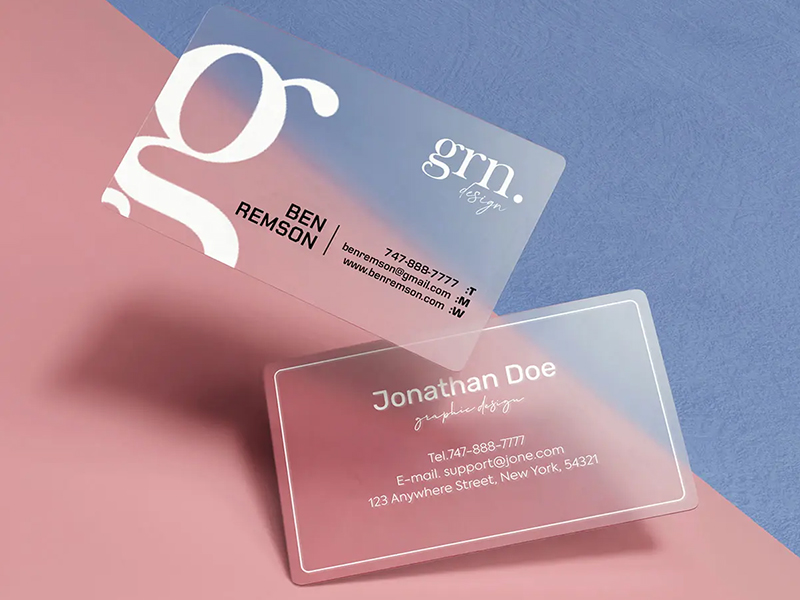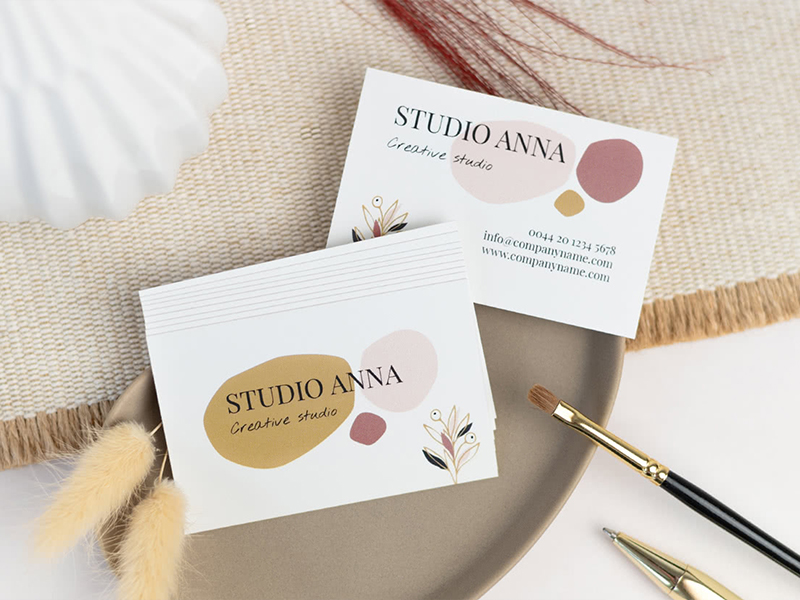TABLE OF CONTENTS
Key Takeaways
-
Understand the Impact: The finish of your business card can significantly affect first impressions and how your brand is perceived. Choose a finish that aligns with your brand's image.
-
Know Your Options: Familiarize yourself with various types of finishes like matte, glossy, and specialty options to make an informed decision.
-
Consider Benefits: Each finish offers unique benefits, such as durability, aesthetic appeal, and tactile experience. Weigh these advantages based on your specific needs.
-
Make an Informed Choice: Consider factors like industry standards, target audience preferences, and the purpose of the card when selecting a finish.
-
Compare Matte and Glossy: Understand the differences between matte and glossy finishes to determine which best suits your brand's message and visual identity.
-
Stay Updated on Trends: Keep an eye on emerging trends in business card finishes to stay ahead in a competitive market.
Importance of Business Card Finishes
First Impressions Matter
A business card often creates the first impression. The finish can greatly influence how it is perceived. A high-quality finish like gloss laminated business cards can make a card stand out.
People tend to remember cards that feel premium. Smooth finishes or textured options can leave a lasting impact. This sets the tone for future interactions.
Reflecting Professionalism
A well-finished business card reflects professionalism. It shows that you care about details. This attention to detail can enhance credibility.
Trustworthiness increases when your card looks polished. Clients and partners are more likely to take you seriously. Professional finishes convey reliability and competence.
Enhancing Brand Identity
Different finishes, like the spot UV business cards, can align with brand aesthetics. A matte finish might suit a modern brand, while glossy could fit a luxury one. These choices help reinforce brand colors and logos.
Consistency is key in branding. Your business cards should match other materials like brochures and websites. This uniformity strengthens your brand identity.
Types of Business Card Finishes
Matte Finish
A matte finish provides a non-reflective surface. It feels smooth to the touch. The lack of shine gives it a sophisticated look. This finish is ideal for a more understated and professional appearance.
Glossy Finish
A glossy finish is shiny and reflective. It makes colors appear more vibrant. This finish grabs attention and is perfect for eye-catching designs and unique business card finishes. Businesses use it to make their cards stand out.
Embossed Finish
Embossing involves pressing a design into the card. This creates a raised texture on the surface. It adds a tactile element that people can feel. This finish is great for emphasizing logos or names, making them stand out.
Spot UV Finish
Spot UV coating applies a glossy layer to specific areas of the coated printing paper card. This highlights certain parts, like logos or text. It adds contrast and emphasis. This finish helps important details pop against the matte background.
Benefits of Different Finishes
Durability and Longevity
Different finishes can significantly impact the durability of business cards. Glossy finishes, for instance, provide a protective layer that resists stains and moisture. This makes them less prone to damage. Matte finishes, while elegant, may show wear more quickly but can still offer good resistance if combined with a laminate.
Resistance to wear and tear is crucial for maintaining a professional image. A card that looks pristine even after weeks of handling speaks volumes about attention to detail. UV coating offers excellent protection against scratches and scuffs. It ensures the card remains in top condition for longer periods.
Longevity is vital for a lasting impression. A business card that deteriorates quickly reflects poorly on the brand. Investing in durable finishes can prevent this issue. High-quality finishes like silk or suede add an extra layer of durability, keeping custom velvet business cards looking new.
Visual Appeal
Finishes play a significant role in enhancing the visual appeal of business cards. Glossy finishes make colors appear more vibrant and eye-catching. They help designs pop and stand out among other cards. Matte finishes offer a more subdued yet sophisticated look, which can be very appealing.
The overall aesthetic quality improves with the right finish. Spot UV, for example, highlights specific areas of the design, creating contrast and depth. This technique draws attention to business card features like logos or contact information.
Finishes also affect how light interacts with the card. Metallic finishes reflect light differently, adding a unique shimmer. This can make the card look more luxurious and high-end.
Tactile Experience
The tactile experience of a soft touch business card is crucial in creating a memorable impression. Touching a business card should feel pleasant and engaging. Different finishes provide unique tactile sensations that can leave a lasting mark on recipients.
Textured finishes like linen or canvas add a distinct feel to the card, as do velvet laminated business cards. These textures engage the sense of touch, making the card more interesting to hold. Soft-touch finishes offer a velvety feel that exudes luxury and sophistication.
Texture plays a significant role in engaging recipients. A card that feels different from others will likely be remembered longer. Embossed or debossed finishes add raised or recessed elements to the card, providing an additional layer of tactile interest.
Choosing the Right Finish
Industry Standards
Different industries have different standards for business card finishes. The matte finish is common in corporate settings. It gives a professional look and reduces glare. The glossy finish is popular in creative fields like design and photography. It enhances colors and makes images pop.
Adhering to industry norms is crucial. It ensures that your card aligns with what others expect. For instance, a lawyer's card with a glossy finish might seem out of place. Following these standards can help you make the right impression.
Personal Preferences
Personal taste plays a big role in choosing a business card finish. Some people prefer a smooth, sleek look. Others like a textured feel. Your choice should reflect your style.
Aligning finishes with individual style is important. A minimalist might prefer a simple matte finish. Someone with a bold personality might choose a high-gloss or metallic finish. These choices help create unique cards that stand out.
Target Audience Considerations
The target audience also influences the choice of finish. Understanding their expectations is key. If your audience values luxury, consider using foil stamping or embossed business cards. These finishes add a touch of elegance.
For younger audiences, trendy finishes like spot UV can be appealing. Spot UV highlights specific parts of the foil business cards, making it eye-catching. Knowing what your audience likes helps you choose the right finish.
Matte vs Glossy Finish
Visual Differences
Matte finishes have a dull, non-reflective surface. They give a soft, subtle look to business cards. Colors appear muted and sophisticated. Designs with fine details stand out well.
Glossy finishes are shiny and reflective. They make colors vibrant and eye-catching. The glossy surface can enhance bold designs. However, glare can sometimes reduce readability.
Practical Applications
Matte finishes suit professional settings. They are ideal for law firms, consulting agencies, and corporate events. Matte cards are easy to read under various lighting conditions.
Glossy finishes work well for creative industries. Advertising agencies, photographers, and fashion designers benefit from the vibrant look. Glossy cards attract attention at trade shows and exhibitions.
Pros and Cons
Matte Finishes:
-
Pros:
-
Elegant and professional appearance
-
Better readability in bright light
-
Resistant to fingerprints
-
-
Cons:
-
Colors may appear less vibrant
-
Can be more expensive
-
Glossy Finishes:
-
Pros:
-
Bright and vivid colors
-
Eye-catching and attractive
-
Durable against moisture
-
-
Cons:
-
Prone to fingerprints and smudges
-
Glare can affect readability
-
Specialty Finishes
Embossing and Debossing
Embossing raises the design on the card's surface. Debossing presses the design into the card. Both techniques create a 3D effect that adds depth.
Embossed designs feel elevated to the touch. Debossed designs feel indented. These finishes enhance logos, names, or patterns.
Suitable elements for embossing and debossing include:
-
Logos
-
Borders
-
Text highlights
Foil Stamping
Foil stamping applies a thin layer of metallic foil to the embossed gloss business cards. This technique uses heat and pressure to transfer the foil.
The result is a shiny, reflective finish. It makes business cards look luxurious and high-end. Foil stamping is perfect for brands aiming for an elegant image.
Common uses for foil stamping:
-
Company logos
-
Names and titles
-
Decorative elements
Soft Touch Coating
Soft touch coating adds a velvety texture to coated printing paper business cards. This finish feels smooth and soft, similar to suede.
It provides a unique tactile experience. The coating also enhances colors, making them appear richer. Soft touch coating is ideal for premium and elegant designs.
Designs that benefit from soft touch coating:
-
Minimalist layouts
-
High-quality images
-
Sophisticated color schemes
Tips for Selecting Finishes
Budget Considerations
Different finishes come with different costs. Glossy finishes usually cost less than matte or textured ones. Foil stamping and embossing are more expensive options.
For budget-friendly choices, consider glossy or matte finishes. These provide a professional look without breaking the bank. Balancing cost and quality is crucial. A cheaper finish might save money but could affect the card’s durability.
Design Compatibility
Finishes interact uniquely with design elements. Glossy finishes make colors pop, while matte offers a subdued look. Textured finishes add depth but can interfere with intricate designs.
Testing finishes with your specific design is important. Some finishes may highlight certain elements while dulling others. For example, foil stamping works well with bold designs but may overwhelm delicate details.
Certain finishes can present design challenges. Textured finishes might obscure small text or fine lines. Always test a sample before finalizing your choice.
Print Quality
Finishes impact print quality significantly. High-resolution printing is essential for clear, sharp images. Glossy finishes enhance color vibrancy, while matte reduces glare.
High-resolution printing ensures that details remain crisp. Low-quality printing can result in blurred images and text, regardless of the finish used. Finishes can either enhance or detract from print clarity. You can Shop by finish for quality material options to ensure a long-lasting impression on your brand's identity.
Real-World Examples
Case Study 1
A tech startup launched in 2018 used a matte finish for their business cards. The matte texture gave a smooth, non-glossy appearance. It helped in reducing glare under bright lights.
This choice made the cards easy to read and professional-looking. Clients appreciated the subtle elegance of the matte finish. The startup reported an increase in positive feedback from networking events.
The key takeaway is that matte finishes can enhance readability and provide a sleek look. They are ideal for industries where professionalism is crucial.
Case Study 2
A graphic design firm opted for spot UV coating on their business cards in 2020. They applied it to highlight their logo and company name. This finish created a striking contrast with the rest of the card.
The rationale was to make their brand stand out visually. Clients often commented on the unique feel of the raised, glossy elements. The firm noticed an uptick in client inquiries after distributing these cards.
Spot UV coating on laminated business cards can draw attention to specific areas on a card. It's effective for businesses wanting to emphasize certain details or create a memorable tactile experience.
Case Study 3
In 2021, a luxury real estate agency chose foil stamping for their business cards. They used gold foil to accentuate their logo and contact information on embossed gloss business cards. The process involved applying heat and pressure to transfer foil onto the card.
The creative process required careful planning to ensure precise alignment. The result was an elegant, high-end finish that resonated with their upscale clientele. Clients often remarked on the card's luxurious feel.
The agency saw an increase in referrals and client retention rates. Foil stamping can add a touch of sophistication and exclusivity, making it suitable for high-end brands.
Future Trends in Card Finishes
Sustainable Materials
Businesses now prioritize eco-friendly options for card finishes. Sustainability is crucial in modern business practices. Companies use materials that have less impact on the environment.
e sustainable materials include:
-
Recycled paper
-
Bamboo
-
Cotton paper
Recycled paper reduces waste by reusing old materials. Bamboo grows quickly, making it a renewable resource. Cotton paper is biodegradable and durable. These materials help businesses show their commitment to the environment.
Technological Innovations
Recent advancements have transformed business card finishing techniques. New methods and materials offer more choices. One notable innovation is digital embossing. This technique uses digital technology to create raised designs without traditional dies.
Another advancement is laser cutting. Laser cutting allows for intricate designs with high precision. UV coating has also improved, providing better protection and a glossy finish.
Technology impacts the quality of finishes. It provides more customization and durability options. Businesses can now create cards that stand out with unique textures and effects.
Customization Options
There are many customization options available for business card finishes. Tailoring finishes to specific needs is important. It helps create unique and memorable cards.
e popular customization options include:
-
Foil stamping
-
Spot UV coating
-
Die-cut shapes
Foil stamping adds a metallic sheen, making cards look elegant. Spot UV coating highlights specific areas, creating contrast. Die-cut shapes provide creative freedom by allowing custom shapes.
Customization plays a key role in branding. It helps businesses make a strong impression on clients and partners. Unique finishes reflect the company's identity and values.
Related Guides
All content inside Guides type
543
Discover a wide range of unique gift ideas for any occasion. Stand out from the crowd with our curated selection of 4040 cool and one-of-a-kind gifts in 2024.
Related Location
Browse our related location
772
Get high-quality business cards in San Francisco. Stand out from the competition with our unique designs and fast turnaround times.
738
Get high-quality business cards in Nashville. Stand out from the competition with our professional designs and fast turnaround time.


